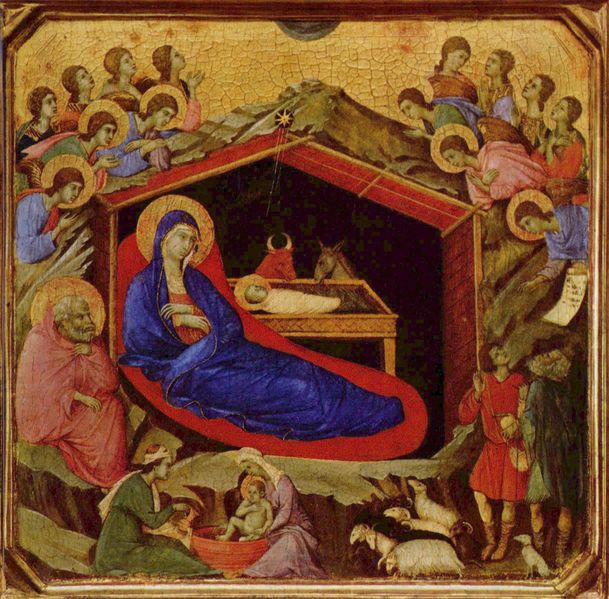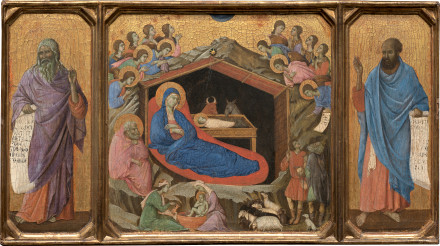One who has not grasped the mystery of Christmas has failed to grasp the decisive element in Christianity. One who has not accepted this cannot enter the kingdom of heaven – and this is what [St. Francis of Assisi] wished to recall anew to the Christians of his own day and of every succeeding generation.
Francis directed that an ox and an ass should be present [in the crèche] in the cave of Greccio on Christmas night. He had told the nobleman John: “I wish in full reality to awaken the remembrance of the child as he was born in Bethlehem and of all the hardship he had to endure in his childhood. I wish to see with my bodily eyes what it meant to lie in a manger and sleep on hay, between an ox and an ass.”
From then on, the ox and ass have had their place in every crib scene – but where do they actually come from? It is well known that the Christmas narratives of the New Testament do not mention them. When we investigate this question, we discover an important factor in all the customs associated with Christmas and, indeed, in all the Christmas and Easter piety of the Church in both liturgy and popular customs.
The ox and ass are not simply products of the pious imagination: the Church’s faith in the unity of the Old and New Testaments has given them their role as an accompaniment of the Christmas event. We read in Isaiah: “The ox knows its owner, and the ass its master’s crib; but Israel does not know, my people does not understand.” (1:3) The Fathers of the Church saw in these words a prophecy that pointed ahead to the new people of God, the Church consisting of both Jews and Gentiles.
Before God, all men, Jews and Gentiles, were like the ox and ass, without reason or knowledge. But the child in the crib has opened their eyes so that they now recognize the voice of their Master, the voice of their Lord. It is striking to note in the mediaeval pictures of Christmas how the artists give the two animals almost human faces and how they stand before the mystery of the child and bow down in awareness and reverence.
But after all, this was only logical, since the two animals were considered the prophetical symbol for the mystery of the Church – our own mystery, since we are but oxen and asses vis-à-vis the Eternal God, oxen and asses whose eyes are opened on Christmas night, so that they can recognize their Lord in the crib. Who recognized him, and who failed to recognize him? But do we really recognize him?

When we place the ox and ass beside the crib, we must remember the whole passage in Isaiah, which is not only good news – in the sense of the promise of a future knowledge – but also a judgment pronounced on contemporary blindness. The ox and ass have knowledge, “but Israel does not know, my people does not understand.”
Who is the ox and ass today, and who is “my people” without understanding? How can we recognize the ox and the ass? How can we recognize “my people”? And why does the lack of reason recognize, while reason is blind?
In order to discover the answer, we must return with the Fathers of the Church to the first Christmas. Who recognized him? And who failed to recognize him? And why was this so?
The one who failed to recognize him was Herod, who did not even understand when they told him about the child: instead, he was blinded all the more deeply by his lust for power and the accompanying paranoia. (Mt 2:3) Those who failed to recognize him were “all Jerusalem with him.” (ibid.) Those who failed to recognize him were the “people in soft garments” – those with a high social position. (Mt 11:8) Those who failed to recognize him were the learned masters who were experts in the Bible, the specialists in biblical interpretation who admittedly knew the correct passage in Scripture but still failed to understand anything. (Mt 2:6)
Those who recognized him were the “ox and the ass” (in comparison to these men of prestige): the shepherds, the Magi, Mary and Joseph. But could things have been otherwise? Those with a high social position are not in the stable where the child Jesus lies: that is where the ox and the ass have their home.
And what about us? Are we so far away from the stable because our garments are much too soft and we are much too clever? Do we get entangled to such an extent in learned exegesis of the Scriptures, in demonstrations of the inauthenticity or the historical accuracy of individual passages, that we become blind to the child himself and perceive nothing of him?
Are we so much “in Jerusalem,” in the palace, at home in ourselves and in our arrogance and our paranoia, that we cannot hear at night the voice of the angels and then set out to adore the child?
In this night, then, the faces of the ox and the ass look at us with a question: My people does not understand, but do you perceive the voice of your Lord? When we place the familiar figures in the crib scene, we ought to ask God to give our hearts the simplicity that discovers the Lord in the child – just as Francis once did in Greccio. For then we, too, might experience what [Thomas of Celano] relates about those who took part in Midnight Mass in Greccio – and his words echo closely Saint Luke’s words about the shepherds on the first Christmas night – each one went home full of joy.
Merry Christmas from all of us at The Catholic Thing:
Robert Royal, Brad Miner, Hannah Russo, and Emily Rowles.
Today’s column is excerpted from Joseph Ratzinger, The Blessing of Christmas, trans. Brian Harrison published by Ignatius Press.
**Image: The Nativity with the Prophets Isaiah and Ezekiel [center panel] by Duccio di Buoninsegna, c. 1310 [National Gallery, Washington, D.C.] The ox and the ass peer into the crib.















